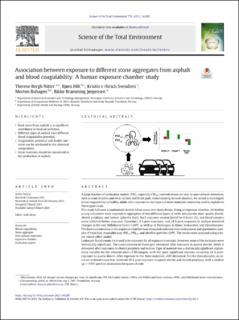| dc.description.abstract | A large fraction of particulate matter (PM), especially PM10, concentrations are due to non-exhaust emissions, such as road abrasion and wear on tires and brake pads. Concentrating on road abrasion, we aimed to investigate blood coagulability in healthy adults after exposure to two types of stone materials commonly used in asphalt on Norwegian roads.
This study followed a randomized, double-blind, cross-over study design. Using an exposure chamber, 24 healthy young volunteers were exposed to aggregates of two different types of rocks and placebo dust: quartz diorite, rhomb porphyry, and lactose (placebo dust). Each exposure session lasted for 4 hours (h), and blood samples were collected before exposure (baseline), 4 h post-exposure, and 24 h post-exposure to analyse potential changes in the von Willebrand factor (vWF) as well as of fibrinogen, d-dimer, leukocytes, and thrombocytes. The dust concentration in the exposure chamber was measured with real-time instruments and gravimetric samples of total dust, respirable dust, PM10, PM2.5, and ultrafine particles (UFP). The results were analysed using a linear mixed-effect model.
Leukocyte blood counts increased post-exposure for all exposure materials; however, none of the increases were statistically significant. The concentration of fibrinogen increased after exposure to quartz diorite, while it decreased after exposures to rhomb porphyry and lactose. Type of material was a statistically significant explanatory variable for the concentration of fibrinogen, with the most significant increase occurring 24 h post-exposure to quartz diorite. After exposure to the three materials, vWF decreased. For the thrombocytes, an increase in blood count was observed 24 h post-exposure to quartz diorite and rhomb porphyry, with a modest (p = 0.09) positive association for quartz diorite.
Although the results are limited, we conclude that the different effects observed post-exposure to quartz diorite support considering potential health effects when choosing materials in the production of asphalt. | en_US |

